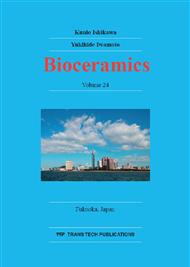p.88
p.94
p.100
p.105
p.109
p.114
p.119
p.123
p.129
Fabrications of Boron-Containing Apatite Ceramics via Ultrasonic Spray-Pyrolysis Route and their Surface Properties
Abstract:
Boron-containing hydroxyapatite (BAp) powders with Ca/(P+B) molar ratio of 1.67 (x=0.4, 0.5, and 0.6) were prepared by an ultrasonic spray-pyrolysis (USSP) technique. The resulting BAp powders were uniaxially compressed to fabricate the green compacts. The BAp ceramics were fabricated by firing the compacts at 1200 °C for 5 h. The crystalline phases of the BAp (x=0.4) ceramics were bipahses of apatite and small amounts of α-tricalcium phosphate (a-Ca3(PO4)2; α-TCP). Meanwhile, HAp and BAp (x=0.5 and 0.6) ceramics were apatite single phase. The dense BAp ceramics with relative density of 90% over were fabricated from the powder of x=0.5 and 0.6. The static contact angles of the BAp ceramics (x=0.5 and 0.6) increased with an increase of pH; meanwhile, the surface potential decreased with an increase of pH. These changes in surface properties may be due to the increase of OH group in B(OH)3 formed via dissociation of BO2 group in BAp.
Info:
Periodical:
Pages:
109-113
Citation:
Online since:
November 2012
Authors:
Price:
Сopyright:
© 2013 Trans Tech Publications Ltd. All Rights Reserved
Share:
Citation:


